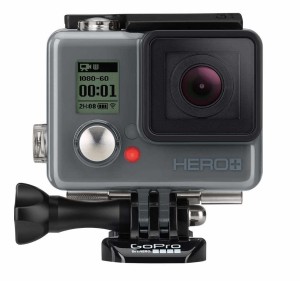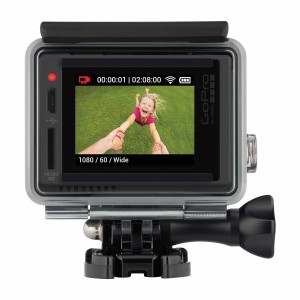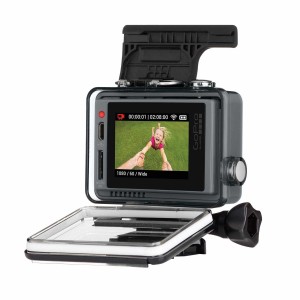6 June 2015 – GoPro has just released the new GoPro Hero+ LCD in the U.S., with worldwide orders following from July 2015. This camera builds on the platform introduced with the GoPro Hero in October 2014, but adds a rear LCD touchscreen, wifi and Bluetooth connectivity, and higher video specs. It also more than doubles the price, from $129 to $299.
 The release of the GoPro Hero+ LCD is interesting in two respects. Firstly, it comes in the summer rather than the fall, suggesting that GoPro may be moving away from product launches only once a year. Secondly, it builds on the entry level range launched with the Hero last October, and as discussed below, encroaches in a number of respects on the Hero 3+ Silver. This is clearly a concious decision by GoPro – the Hero 3 and 3+ models have been discontinued (though they are still widely available) leaving a choice now between the more basic Hero models, and the high end Hero 4 Session, Silver and Black models.
The release of the GoPro Hero+ LCD is interesting in two respects. Firstly, it comes in the summer rather than the fall, suggesting that GoPro may be moving away from product launches only once a year. Secondly, it builds on the entry level range launched with the Hero last October, and as discussed below, encroaches in a number of respects on the Hero 3+ Silver. This is clearly a concious decision by GoPro – the Hero 3 and 3+ models have been discontinued (though they are still widely available) leaving a choice now between the more basic Hero models, and the high end Hero 4 Session, Silver and Black models.
Spec wise, the Hero+ LCDadds the same built-in display as the Hero 4 Silver. As we’ve discussed previously, this dramatically increases the usability of the camera, both in terms of framing and reviewing footage, and also in relation to changing the settings. The Hero+ LCD also adds wifi and Bluetooth connectivity, which means that it can (unlike the basic Hero) be used with the smartphone app.
 Although the new screen gets all the headlines, another more subtle amendment is the bump in the top video resolution setting from 1080p30 to 1080p60 – that is, the Hero+ LCD will shoot full HD video at 60 frames per second. This doubling of framerate over the basic hero means that some degree of slow-motion footage is now available on the Hero+ LCD; nothing like the 240fps at full HD on the Hero 4 Black, but still a definite step change. What is more, this improvement in the video specs means that the Hero+ LCD now has the same video specs as the Hero 3+ Silver, and costs the same amount ($300), but also has the LCD touchscreen.
Although the new screen gets all the headlines, another more subtle amendment is the bump in the top video resolution setting from 1080p30 to 1080p60 – that is, the Hero+ LCD will shoot full HD video at 60 frames per second. This doubling of framerate over the basic hero means that some degree of slow-motion footage is now available on the Hero+ LCD; nothing like the 240fps at full HD on the Hero 4 Black, but still a definite step change. What is more, this improvement in the video specs means that the Hero+ LCD now has the same video specs as the Hero 3+ Silver, and costs the same amount ($300), but also has the LCD touchscreen.
However, the Hero 3+ Silver does still have a key potential advantage over the Hero+ LCD – the camera is removable from the case, which means that the rechargeable battery can be swapped out for a fresh one when it is dead. Whether this is important to you depends very much on how you intend to use the GoPro. It may be the case that the majority of people who own a GoPro (even one with a replaceable battery) don’t actually buy a spare battery, and are quite content with the amount of run time provided by a single charge. On the other hand, having the ability to swap out an expired battery for a fresh one is a real benefit where shooting on a day long trip, especially now that high capacity micro SD cards to store all that footage are so affordable. It’s also definitely the case that making use of the Touch LCD screen on the Hero+ LCD will eat into the battery power available for recording video. The Hero 3 Silver also beats the Hero+ LCD for still photos – with 10 MP at 10 fps for the Silver, vs 8 MP at 5 fps for the Hero+ LCD
On the other hand, as the more up-to-date camera, the GoPro Hero+ LCD does feature GoPro’s SuperView, Quick Capture and auto low light settings. The inclusion of the SuperView in particular is a definite step up over the Hero 3+ if you think the setting will be useful for they type of shooting you intend to do – it’s particularly good for POV footage where the camera is mounted on your body, as it helps capture as much of both the horizontal and vertical image as possible.
Also competing with the Hero+ LCD is the Hero 4 Silver, which is $100 more than the Hero+ LCD at $400. That extra cash buys you a replaceable battery set up, but also steps up the video specs at the more-than-HD resolutions to 4K (albeit at a less than ideal 15fps), or 2.7K at 30fps. At full HD the video spec is no better than the Hero+ LCD, at with 60fps at 1080p, though at 720p the framerate is 120fps, giving a proper slow motion capability.
As can be seen from the above, there are a number of competing factors in deciding between the GoPro Hero +, 3+ Silver and 4 Silver – we’ve summarised the main different features here:
| GoPro Hero + | GoPro Hero 3+ Silver | GoPro Hero 4 Silver | |
|---|---|---|---|
| Price | $299 | $299 | $399 |
| LCD Touchscreen | Yes | No | Yes |
| Removable battery | No | Yes | Yes |
| Max video resolution | 1080p60 720p60 | 1080p60 720p60 | 4K at 15fps 2.7k at 30fps 1080p60 720p120 |
| Max photo resolution | 8MP 5fps burst | 10MP 10fps burst | 12MP 30fps burst |
| SuperView mode | Yes | No | Yes |
Conclusion
The release of the GoPro Hero+ LCD is an interesting and clever tactical move by GoPro. It has instantly given them a competitor to the Garmin VIBR Elite and the Sony HDR AS100 which previously looked like a cheaper alternative to the GoPro range for those who wanted a built screen. It has also done so in a way that doesn’t cannibalise from its own range – the GoPro Hero is still available for those looking for a cheap entry point to the range, while the Hero 4 Silver has sufficient additional features to justify its $100 premium over the Hero+ LCD. Only the Hero 3 and 3+ now look a bit in the shadows and, as discussed above, this is not surprising given that they have now been officially phased out in favour of the newer models.
 We anticipate that the GoPro Hero+ LCD will become a big seller for GoPro – indeed, its combination of 1080p60, a touch LCD screen, wifi/Bluetooth connectivity and an affordable price tag may make it the perfect action cam for a lot of users – provided they can live with the single shot battery. For those who need a replaceable battery setup, the step up to the Hero 4 Silver, with all the additional benefits it brings, is probably worth the extra $100.
We anticipate that the GoPro Hero+ LCD will become a big seller for GoPro – indeed, its combination of 1080p60, a touch LCD screen, wifi/Bluetooth connectivity and an affordable price tag may make it the perfect action cam for a lot of users – provided they can live with the single shot battery. For those who need a replaceable battery setup, the step up to the Hero 4 Silver, with all the additional benefits it brings, is probably worth the extra $100.
